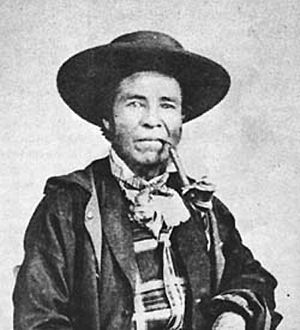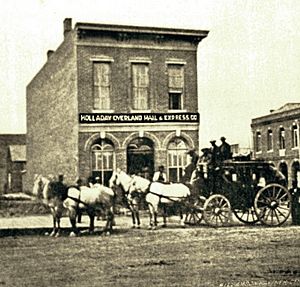Fort Namaqua facts for kids
Quick facts for kids
Fort Namaqua
|
|
|---|---|
|
Trading post
|
|
| Nickname(s):
Modena's Crossing, Namaqua Station, Mariano's Crossing, Big Thompson, Miraville
|
|
| Country | United States |
| State | Colorado |
| County | Larimer |
| Town | Loveland |
Fort Namaqua, also called Mariano's Crossing or Namaqua Station, was a busy trading post that opened around 1858 or 1859. It was located in what is now Loveland, Colorado, in Larimer County, Colorado. By 1862, it became a stage station, a place where travelers could rest and change horses along the trails to Denver.
A fort was built there after 60 horses were stolen from the property. The founder, Mariano Medina, also started a small settlement with people from his hometown of Taos, New Mexico. The site was officially named Namaqua in 1868 when a post office was added. The buildings were used until the 1920s and were later taken apart. Today, a historical marker stands at Namaqua Park, close to where the fort and station once were.
Contents
The Story of Fort Namaqua
Who Was Mariano Medina?
Mariano Medina (sometimes called Modena) was a scout from Taos, New Mexico. He started one of the very first businesses in Colorado before it became a state. This business was a stage station and trading post.
His post was in a great spot where many important trails crossed. These included the Texas and Overland Trails, the Denver and Laramie Trails, and paths branching off the South Platte and old Oregon Trails.
Medina could speak Spanish and English. He probably also knew some French and Native American languages. This is because his wife was Native American, and French fur trappers were common in the area.
Building the Fort and Settlement
The fort was located west of today's Namaqua Road. It was on the north side of the Big Thompson River. Here, Medina built and ran a toll bridge, where people paid to cross.
Mariano Medina was the first person to settle permanently in the Big Thompson Valley. He built log buildings and invited people from his hometown of Taos to join him. Together, they created a settlement that grew to about 100 people.
In 1861, a group of Ute people took 60 of his horses. Medina chased them for 25 miles and shot one of the men before the others ran away. After this, he decided to build a strong stone fort.
The fort was built on the north side of the Big Thompson River. Its walls were very thick, up to 20 inches wide. It had six openings for guns. The roof was made of logs and sandstone slabs, covered with a foot of earth for extra protection.
A Busy Stage Station
In 1862, Fort Namaqua became a stage station for the Holladay Overland Stage company. This company ran stagecoaches along the Cherokee Trail. The station was an important stop between Laporte and Denver.
The site was officially named Namaqua in 1868. This happened when a post office was opened at the fort and stage station. Medina also had a farm in the area. He was buried there when he passed away in 1878.
What Happened Next?
After the fort was no longer needed, the stone building was changed into an ice house. The log buildings continued to be used until the 1920s. After that, they started to fall apart and were taken down.
However, Mariano Medina's cabin was saved and restored. You can now see it at the Loveland Museum. In 1960, Medina's grave was moved to Namaqua Park. A special marker was placed in the park, close to where the old stage station once stood.




